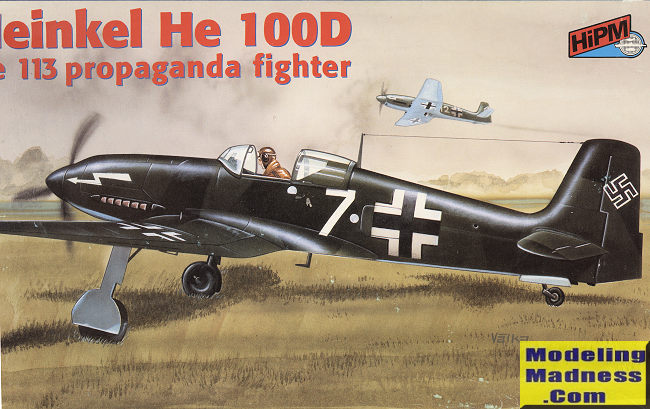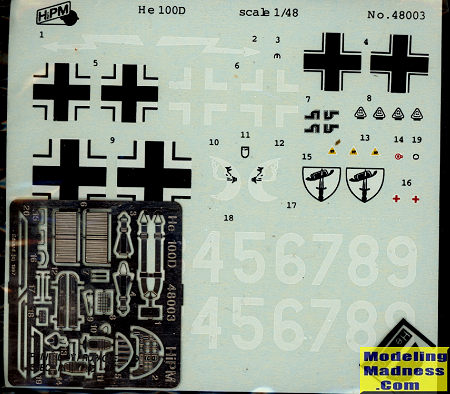
HiPM 1/48 He-100D
| KIT #: | 48-003 |
| PRICE: | £ |
| DECALS: | Multiple number options for three fake units. |
| REVIEWER: | Scott Van Aken |
| NOTES: | Short run with photo etch parts |

| HISTORY |
The Heinkel He 100 was a German pre-World War II fighter aircraft design from Heinkel. Although it proved to be one of the fastest fighter aircraft in the world at the time of its development, the design was not ordered into series production. Approximately 19 prototypes and pre-production examples were built. None are known to have survived the war.
The reason for the He 100 failing to reach production status is mostly unknown. Officially, the Luftwaffe rejected the He 100 to concentrate single-seat fighter development on the Messerschmitt Bf 109. Following the adoption of the Bf 109 and Messerschmitt Bf 110 as the Luftwaffe's standard fighter types, the Ministry of Aviation (the Reichsluftfahrtministerium or RLM) announced a "rationalization" policy that placed fighter development at Messerschmitt and bomber development at Heinkel.
Because there are no surviving examples, and since many factory documents - including all blueprints for the He 100 - were destroyed during a bombing raid, there is limited specific information about the design and its unique systems.
The final evolution of the short He 100 history is the D-1 model. As the name suggests, the design was supposed to be very similar to the pre-production D-0s, the main planned change being to enlarge the horizontal stabilizer.
But the big change was the eventual abandonment of the surface cooling system, which proved to be too complex and failure-prone. Instead an even larger version of the retractable radiator was installed, and this appeared to completely cure the problems. The radiator was inserted in a "plug" below the cockpit, and as a result the wings were widened slightly.
While the aircraft didn't match its design goal of 700 km/h (430 mph) once it was loaded down with weapons, the larger canopy and the radiator, it was still capable of speeds in the 644 km/h (400 mph) range. A low drag airframe is good for both speed and range, and as a result the He 100 had a combat range between 900 to 1,000 km (560 to 620 mi) compared to the Bf 109's 600 km (370 mi). While not in the same league as the later escort fighters, this was at the time a superb range, which suggests that a production Heinkel 100 might have offset the need for the Bf 110 to some degree.
By this point, the war was under way, and as the Luftwaffe would not purchase the aircraft in its current form, the production line was shut down. There were allegations that politics played a role in killing the He 100.
The remaining 12 He 100 D-1 fighters were used to form Heinkel's Marienehe factory defense unit, flown by factory test pilots. They replaced the earlier He 112s that were used for the same purpose, and the 112s were later sold off. At this early stage in the war, there were no bombers venturing that far into Germany, and it appears that the unit never saw action. The eventual fate of the D-1s remains unknown. The aircraft were also put to an interesting propaganda/disinformation role, as the supposed Heinkel He 113. In fact, the use of what looks like fresh paint behind the markings and possibility that the markings were even painted on paper and then applied made it look like the aircraft had reached unit service. Many Allied pilots report seeing or shooting down the Heinkel fighters.
| THE KIT |
 This is
not a new kit, but amazingly, it is the only one of which I know in 1/48 scale
that is produced in injected plastic. Special Hobby does it in 1/32 and also in
1/72 scale. Of course, HiPM is part of the same conglomeration, but was the
first to be done. As such, it is very typical of the short run kits of the
1990s.
This is
not a new kit, but amazingly, it is the only one of which I know in 1/48 scale
that is produced in injected plastic. Special Hobby does it in 1/32 and also in
1/72 scale. Of course, HiPM is part of the same conglomeration, but was the
first to be done. As such, it is very typical of the short run kits of the
1990s.
It has fine engraved panel
lines, somewhat large sprue gates and relies on photo etch for all the small
details. It also includes an acetate sheet with the instruments. This will be
sandwiched between the p.e. instrument panel and a plastic backing. Other p.e.
parts are tail gear doors, seat harness, radiator screens, rudder pedals, and
some interior bits and pieces for the sidewalls. It is also used for aileron and
rudder control arms as well as wheel downlock indicators and a rudder trim tab
and actuator.
 Some of
these bits are substitutes for plastic parts, but most who end up building this
kit will go with the p.e. for all these items as it is more crisply detailed.
Some of
these bits are substitutes for plastic parts, but most who end up building this
kit will go with the p.e. for all these items as it is more crisply detailed.
We are provided with two canopies; one is a three piece affair if you want it open, and the other is a single closed option. The rest of the airframe is pretty simple. The main gear wells are molded into the lower wing piece and generally devoid of detail. The cockpit will have to be built up from several flat pieces and the prop has separate blades to install on a backing plate. The blades are not keyed. The builder will also need to stretch a bit of sprue and cut a block for the seat to sit upon.
Instructions are well drawn and quite usable with detail drawings to help with some parts placement. All the color info is provided on one sheet with RLM references. These planes were RLM 70/71/65 in a splinter pattern. There were three fake squadrons photographed and the nose markings for all three as well as aircraft numbers are provided on the decal sheet.
| CONCLUSIONS |
Based on those who have built this one, it will take some of those modeling skills to successfully complete. However, it is an important plane that had RAF pilots shooting it down in rather high numbers, even though it never actually saw combat. If you can handle short run, this may well be worth searching.
| REFERENCES |
https://en.wikipedia.org/wiki/Heinkel_He_100
January 2018
Copyright ModelingMadness.com. All rights reserved.
If you would like your product reviewed fairly and fairly quickly, please contact the editor or see other details in the Note to Contributors.
Back to the Main Page Back to the Review Index Page Back to the Previews Index Page